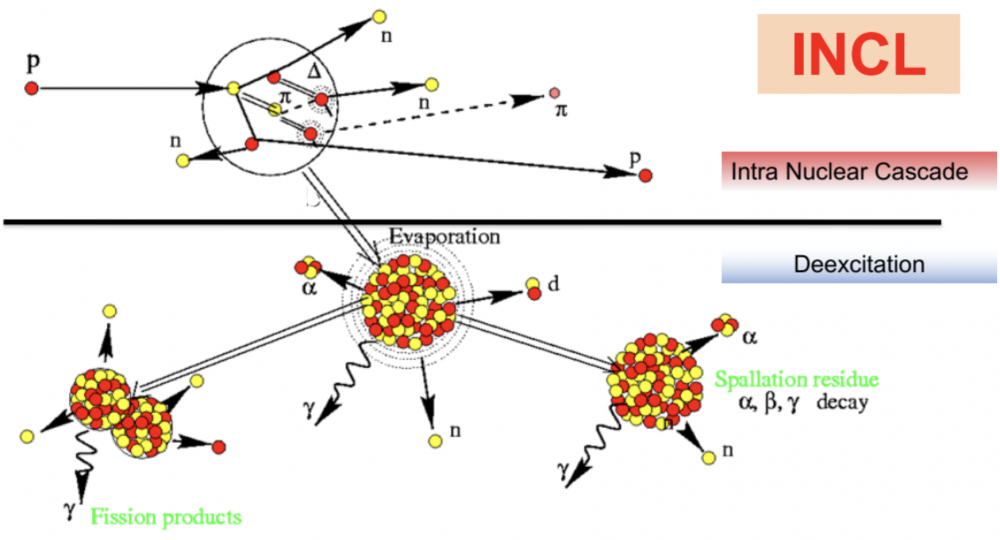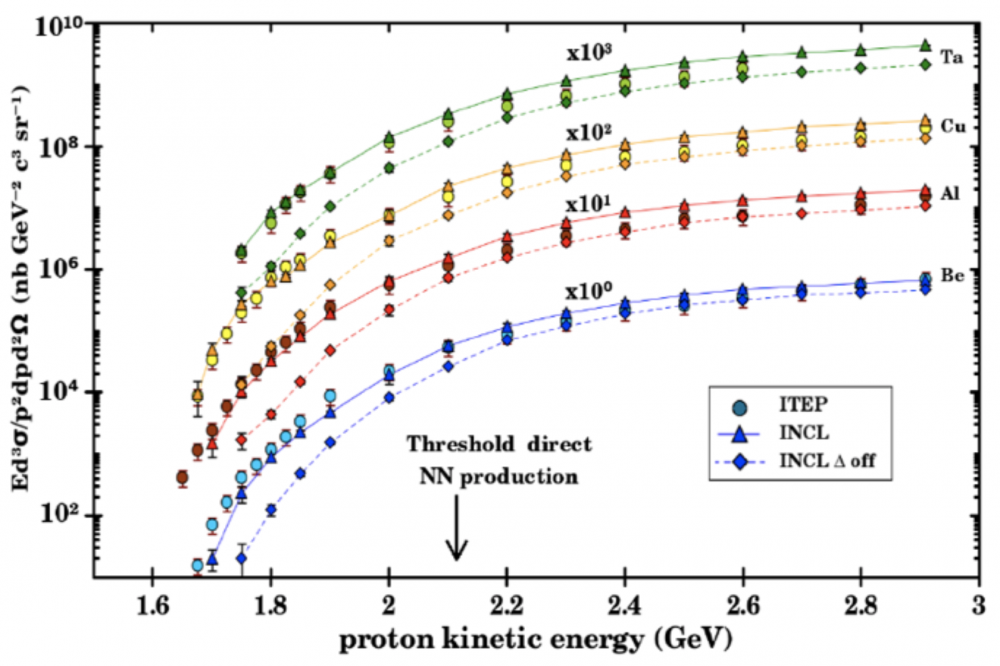INCL (Liège intranuclear cascade) is a simulation code known for its ability to model light particle-nucleus interactions. It is used in very various fields, such as proton therapy, neutron sources, radioactive ion beams or ADS's (Accelerator Driven Systems). In order to extend its capabilities in the field of higher energy reactions, in connection with cosmic rays or with the study of hypernuclei, a team of physicists led by Irfu has recently developed a new version of the code involving strange particles. This work was at the heart of a recently defended thesis (2019) and the new possibilities offered by this code were published in early 2020 in the journal Physical Review C [1].
Medium and high-energy (a few MeV to a few GeV) nuclear reactions have long been studied and modeled at DPhN. A typical reaction is shown in Figure 1. The projectile (here a proton) collides with a nucleus, initially triggering an "intranuclear cascade" before the resulting system de-excites.
The INCL code treats the first part of the reaction and is associated with a so-called de-excitation code which treats the second part. INCL has been continuously improved and its capabilities extended. In particular, in 2010, its qualities were recognized by the IAEA (International Atomic Energy Agency) in a state-of-the-art comparison of particle-nucleus interaction modeling codes. INCL has also been implemented in various particle transport codes (see FM of January 30, 2013). In order to cover more widely the spectrum of cosmic rays, INCL has recently been extended to high energies (up to 20 GeV) [2]. This extension is particularly interesting for the study of nuclei formed by the interaction of cosmic rays (87% H, 12% He, 1% heavier ions) with the bodies it encounters (e.g. meteorites, planets), allowing a better understanding of the history of the latter.
Now, to refine this rise in energy, it is necessary to take into account the production of so-called strange particles, composed of at least one quark s (strange) or its antiquark s in their description in elementary bricks1. This then makes it possible to study the production of hypernuclei, i.e. nuclei where a nucleon is replaced by one or more Λ particles, and thus to study the impact of strangeness on the fundamental properties of nuclei (for example its lifetime).

Figure 1: Example of a reaction processed by INCL. Upper part, 1st stage, the intranuclear cascade (duration: ~10-22 s). A proton (p) hits a nucleus made of protons (p) and neutrons (n), which produces, and causes the emission of particles (e.g. pion (π), Delta (Δ)). The lower part, 2nd step, deals with the de-excitation of the hot remnant nucleus from the cascade (duration: ~10-20-10-16 s).
The strange particles K, Λ, Σ are cousins of more known particles, such as the π for the K (made of a quark and an antiquark) and the nucleon for the Λ and Σ (composed of three quarks). They have been added as new degrees of freedom in the INCL code. However, the addition of these particles requires knowledge of new ingredients managing their production, scattering and/or absorption. For example, cross sections quantifying the possibility of performing these different processes must be added to the code. This exercise is not without difficulty: even considering only the main channels, involving the particles most present in the nucleus (nucleons and pions) and the strange particles, one must take into account about 400 cross sections. The latter come from different sources: i) 17% of the required channels have been measured and the information is therefore available from the experiments, ii) about 50% can be obtained by considering symmetries between the particles (coming from similar behaviors with respect to the strong interaction), iii) the information for the remaining channels should be based on models.
The predictive capacity of INCL, regarding the production of strange particles, has been tested on different experimental data and in particular by looking at i) the rapidity of the Lambda particle and ii) the kinematics of the K+.
For the production of the Λ particle, we used the results of the HADES experiment (GSI, Germany) [4]. This experiment measured the rapidity spectrum: the more the Λ are produced in the direction of the projectile, the higher the rapidity. The result given in Figure 2 shows the experimental points as well as the simulations of three models, including INCL. Within the range of experimental data, the three simulations give quite different results and INCL is able to reproduce the experiment up to a rapidity of 0.8-0.9. Beyond that INCL seems to overestimate the experimental points, but this is only an artifact. This apparent overestimation comes from the fact that, for rapidities above 0.8, the data are extrapolated using a model (UrQMD) which itself predicts less than INCL (see Figure 2).

Figure 3: Production of K+ in a selected kinematic range (polar angle 10.5° and momentum 1280 +/- 14 MeV) in the reactions p+Be, p+Al, p+Cu and p+Ta as a function of proton energy. The experimental data (represented by circles) were taken at the ITEP accelerator.
Depending on the particles emitted and their kinematic characteristics (emission angles, energy), certain elementary channels are dominant in a process.
Figure 3 shows the K+ production as a function of the incident proton energy in a selected kinematic domain for four different targets (Be, Al, Cu, Ta). Experimental data (from an experiment at ITEP, Institute of Theoretical and Experimental Physics, Russia [5]) are compared with INCL predictions taking into account (triangles) or not (diamonds) the production of K+ particles by the Δ particles (excited states of the proton) via ΔN --> K + X reactions (X designating all allowed particle configurations). It is obvious that at low energy the contribution of the Δ particles is essential to reproduce the experimental data.
INCL is now able to model the production of strange particles (K, Λ, Σ) and reproduces rather well the experimental data. It is perfectly competitive with other models and sometimes goes even further by describing experiments that some models cannot simulate in reasonable times.
INCL is promised to future developments. In particular, requests have been made to extend INCL to antiproton-nucleus interactions, both for antiprotons at rest (energy lower or equal to keV) for experiments at CERN on antimatter, and for energetic antiprotons (a few GeV) at FAIR (GSI, Germany) in the framework of the PANDA collaboration for the study of the ΛΛ interaction.
Note
1 In the standard model, quarks are the elementary bricks of matter.
Références
[1] J. Hirtz et al., Phys. Rev. C 101, 014608 (2020)
[2] S. Pedoux et J. Cugnon, Nucl. Phys. A 866, 16-36 (2011)
[3] J. Hirtz et al., Eur. Phys. J. Plus 133:436 (2018)
[4] HADES Collaboration, Eur. Phys. J. A 50:81 (2014).
[5] A. Akindinov et al., JETP Lett. 72, 100 (2000).
Contact
• Structure of nuclear matter › Nuclear reaction dynamics
• Institute of Research into the Fundamental Laws of the Universe • The Nuclear Physics Division
